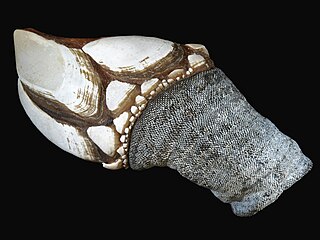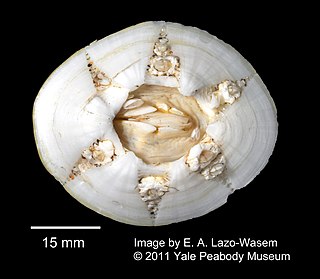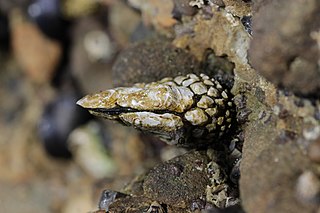
Barnacles are arthropods of the subclass Cirripedia in the subphylum Crustacea. They are related to crabs and lobsters, with similar nauplius larvae. Barnacles are exclusively marine invertebrates; many species live in shallow and tidal waters. Some 2,100 species have been described.

Goose barnacles, also called percebes or turtle-claw barnacles or stalked barnacles or gooseneck barnacles, are filter-feeding crustaceans that live attached to hard surfaces of rocks and flotsam in the ocean intertidal zone. Goose barnacles formerly made up the taxonomic order Pedunculata, but the group has been found to be polyphyletic, with its members scattered across multiple orders of the infraclass Thoracica.

Thecostraca is a class of marine invertebrates containing over 2,200 described species. Many species have planktonic larvae which become sessile or parasitic as adults.

Acorn barnacle and acorn shell are vernacular names for certain types of stalkless barnacles, generally excluding stalked or gooseneck barnacles. As adults they are typically cone-shaped, symmetrical, and attached to rocks or other fixed objects in the ocean. Members of the barnacle order Balanomorpha are often called acorn barnacles.
In the past, Archaeobalanidae has been considered a family of barnacles of the order Sessilia. Research published in 2021 by Chan et al. resulted in the genera of Archaeobalanidae being merged with that of Balanidae, which now contains the members of both families. In the same work, Sessilia was not retained as an order of barnacles.

Elminiidae is a family of symmetrical sessile barnacles in the order Balanomorpha. There are about 5 genera and 12 described species in Elminiidae.

Chelonibiidae is a family of turtle barnacles in the order Balanomorpha. There are at least three genera and about eight described species in Chelonibiidae.
In the past, Platylepadidae has been considered a family of barnacles of the order Sessilia. Research published in 2021 by Chan et al. resulted in the genera of Platylepadidae being merged with that of Balanidae, except Stephanolepas which was moved to Chelonibiidae. In the same work, Sessilia was not retained as an order of barnacles.

Scalpellomorpha is an order of acorn barnacles in the class Thecostraca. There are about 11 families in 3 superfamilies and more than 450 described species in Scalpellomorpha.
Cryptophialidae is a family of Acrothoracican barnacles in the order Cryptophialida, the sole family of the order. There are at least 2 genera and more than 20 described species in Cryptophialidae. These barnacles burrow into calcareous rocks and structures, such as limestone, shells, or corals.
Polyascidae is a family of parasitic barnacles in the class Thecostraca. There are at least two genera and about eight described species in Polyascidae.
Lithoglyptida is an order of barnacles in the class Thecostraca. There are 2 families and more than 40 described species in Lithoglyptida.
Archaeolepadomorpha is an extinct order of barnacles in the class Thecostraca. There are at least 3 families and more than 40 described species in Archaeolepadomorpha.

Brachylepadidae is an extinct family of barnacles in the order Brachylepadomorpha, the sole family in the order. There are about 7 genera and more than 20 described species in Brachylepadidae.
Iblomorpha is a small order of barnacles in the class Thecostraca. There are only two families and about eight described species in Iblomorpha. In this group we find barnacles that use calcium phosphate in their shell, and species that protect themselves against predators with poison.
Eolepadomorpha is an extinct order of barnacles in the class Thecostraca. There are 2 families and about 14 described species in Eolepadomorpha.

Calanticomorpha is an order of acorn barnacles in the class Thecostraca. There are 3 families and more than 90 described species in Calanticomorpha.

Pollicipedomorpha is an order of pedunculated barnacles in the class Thecostraca. There are 3 families and more than 30 described species in Pollicipedomorpha.

Verrucomorpha is an order of asymmetrical sessile barnacles in the class Thecostraca. They are typically found in deeper and deep-sea habitats. There are 2 families and more than 100 described species in Verrucomorpha.
Idioiblidae is a family of normal barnacles in the order Iblomorpha. There are at least three genera and about five described species in Idioiblidae.










